A comprehensive scope document in software development ensures alignment and clarity among all stakeholders. Project managers, startups, and software developers can avoid challenges such as scope creep, misaligned expectations, and budget overruns with a clear project scope. These obstacles can derail a project before it gets off the ground, highlighting the importance of establishing a solid project scope plan from the outset.
Aloa, an expert in software outsourcing, recognizes these challenges and offers tailored solutions to businesses and startups aiming to navigate the complexities of software project management. Aloa ensures that every aspect of the project is meticulously planned and documented. Their approach to the scope of a software project encompasses all critical elements, including stakeholder management, project deliverables, and key milestones, to prevent scope creep and ensure project success.
This blog will explore the essential steps to creating an effective project scope document. We'll also delve into some examples of a project scope plan for software development and its benefits in a project. Afterward, you'll learn to define your project goals, manage scope, and use project management software to keep everything on track.
Let's begin!
How to Build a Scope Document for Software Development
Creating a comprehensive project scope plan is crucial for the success of any software development project. It serves as a blueprint, outlining the project's objectives, deliverables, and timelines, ensuring alignment and understanding among all stakeholders. A well-crafted scope document prevents scope creep, aligns expectations, and manages budget constraints effectively.
Here are seven essential steps to guide you through creating an effective scope document for software development:
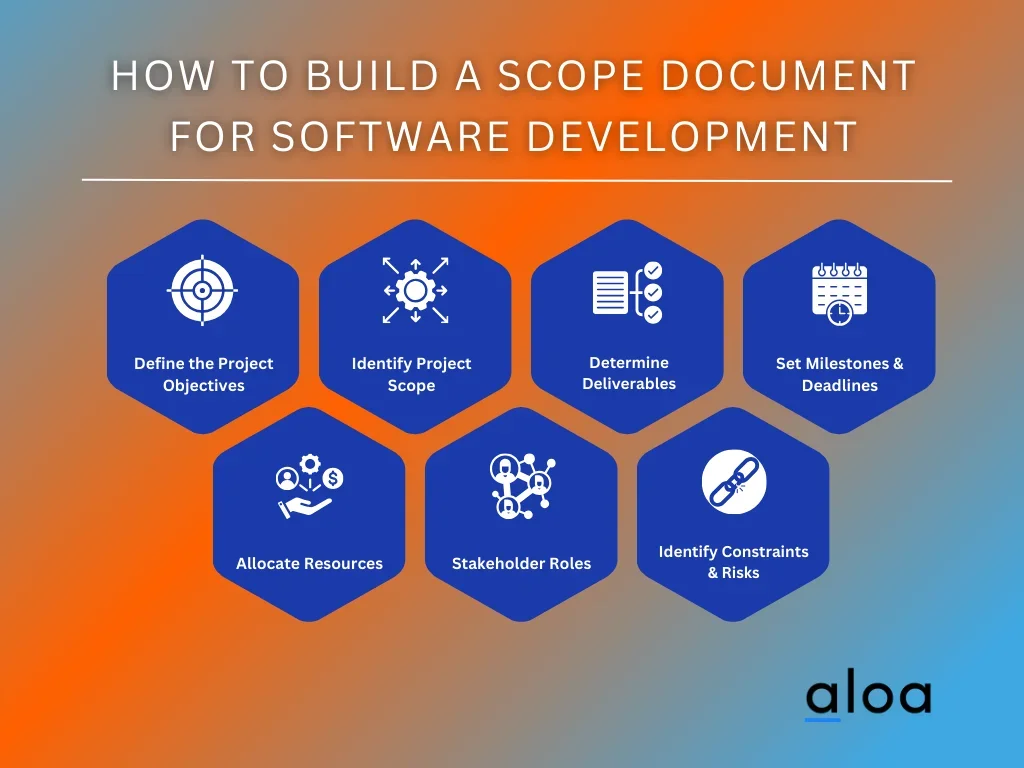
Step 1: Define the Project Objectives
In the initial phase of a software development project, defining clear objectives is crucial. A scope document enables teams to articulate project goals, outlining the specific problems the software aims to solve. The project scope statement within the document can help teams establish a common understanding of the project's scope and limitations. This clarity facilitates effective scope management throughout the project lifecycle, minimizing the risk of scope creep and ensuring alignment with stakeholder expectations.
To define project objectives effectively, here are some key questions:
- What are the project's primary goals?Identifying the main objectives provides direction and focus, ensuring the project delivers value.
- What specific problems does the project aim to solve?Understanding the challenges helps in tailoring solutions that directly address these issues.
- How do these objectives align with the overall business or organizational goals?This alignment ensures that the project contributes to the broader strategic objectives.
- Who are the stakeholders, and how do their needs influence the project objectives?Stakeholder needs must be considered to ensure the project meets or exceeds their expectations.
- What metrics or criteria will measure the project's success?Establishing clear success criteria helps evaluate the project's effectiveness in achieving its goals.
A meticulous definition of project objectives is the foundation for effective project planning, collaboration among team members, and streamlined approval processes. The project team sets the stage for a cohesive and purpose-driven development journey by emphasizing the importance of articulating goals and problem-solving strategies.
Step 2: Identify Project Scope
Identifying the scope is pivotal in any successful venture, especially in software development. This crucial stage lays the groundwork for the entire project, ensuring that the team is aligned with its objectives and understands the boundaries within which it must operate. Without clearly identifying the project's scope, the risk of veering off course and encountering challenges escalates exponentially.
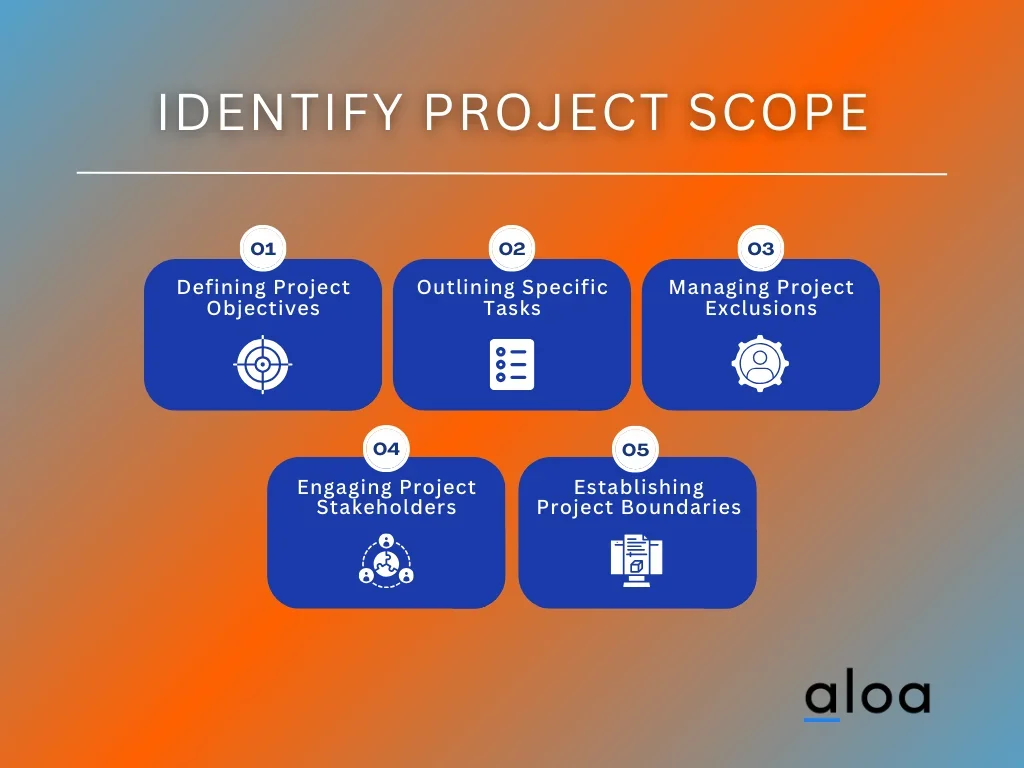
Here are five key considerations in identifying project scope:
- Defining Project Objectives: Clearly articulate the goals and outcomes the project aims to achieve.
- Outlining Specific Tasks: Break down the project into specific tasks and activities to be completed.
- Managing Project Exclusions: Determine what is not included within the scope to prevent scope creep.
- Engaging Project Stakeholders: Involve key stakeholders in defining and validating the project scope to ensure alignment.
- Establishing Project Boundaries: Set clear boundaries to delineate what falls within the project's scope and what does not.
The identification of project scope is the cornerstone upon which the success of a software development project is built. It offers a clear roadmap, defining project boundaries, ensuring stakeholder alignment, facilitating resource allocation, and mitigating risks. This crucial step sets the stage for a streamlined and successful project execution.
Step 3: Determine Deliverables
In the project lifecycle, determining deliverables is crucial to outline the specific outputs or products expected upon project completion. This step ensures clarity and alignment among team members regarding the project's end goals. Consider the following aspects in determining deliverables:
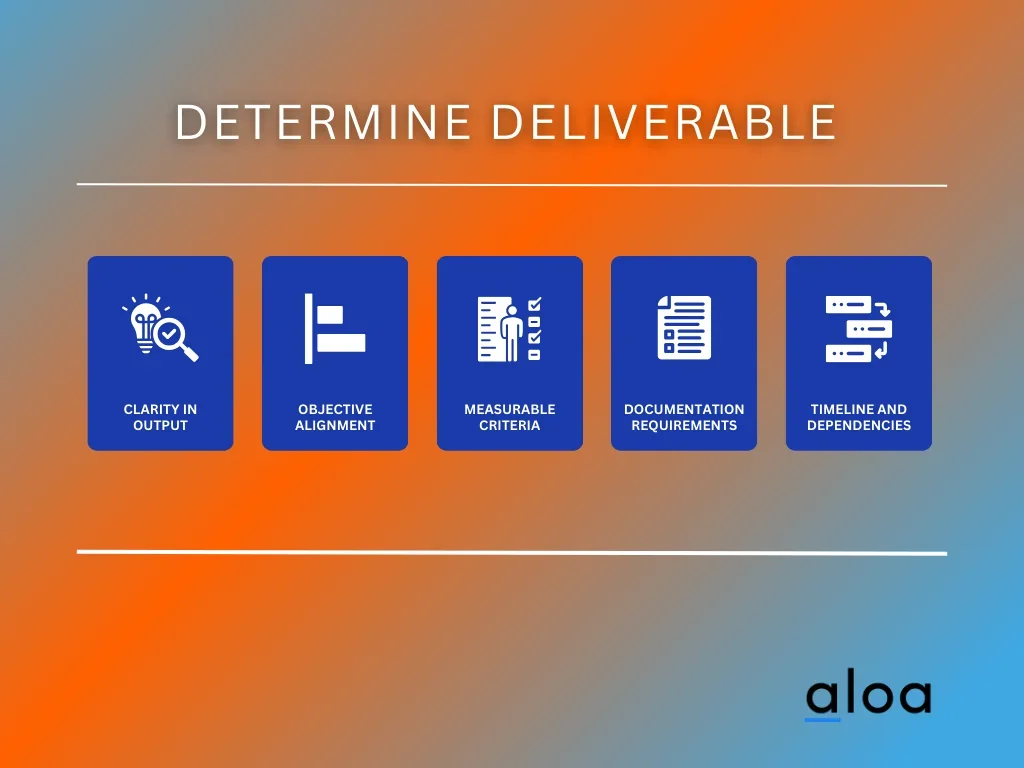
- Clarity in Output: Ensure all project team members clearly define and understand the deliverables.
- Alignment with Project Objectives: The deliverables should directly contribute to achieving the project's objectives and fulfilling the requirements outlined in the scope document.
- Measurable Criteria: Establish measurable criteria to evaluate the quality and completeness of the deliverables.
- Documentation Requirements: Determine any documentation or reporting requirements associated with each deliverable to ensure transparency and accountability.
- Timeline and Dependencies: Consider the timeline and dependencies associated with each deliverable to facilitate efficient project planning and execution.
Determining deliverables is pivotal for project management, guiding teams toward successful outcomes by ensuring clarity, alignment, and accountability throughout the project lifecycle. Adhering to these considerations, project teams can effectively define, track, and deliver the outputs essential for project success.
Step 4: Specify Milestones and Deadlines
In specifying milestones and deadlines, the project team must meticulously outline key checkpoints and delivery dates to ensure project progress and timely completion. This process involves identifying critical phases within the project plan and setting achievable milestones to mark significant progress points. Each milestone should be aligned with project objectives and serve as a tangible measure of success.
To set milestones effectively, project managers should collaborate with team members to identify key project phases and break down tasks into manageable segments. This collaborative approach fosters ownership and accountability among team members, ensuring collective commitment to project milestones and deadlines.
Specifying milestones and deadlines is a crucial aspect of project planning and management. Set clear checkpoints and delivery dates so project teams can track progress, manage resources efficiently, and ensure timely project completion. This proactive approach drives productivity and fosters a culture of accountability across the project team.
Step 5: Allocate Resources
Effective resource allocation is pivotal in software development, ensuring the project's success. This step involves strategically identifying and allocating essential resources such as team members, cutting-edge technologies, and budgetary considerations. Here's how to identify and allocate the necessary resources for your project:
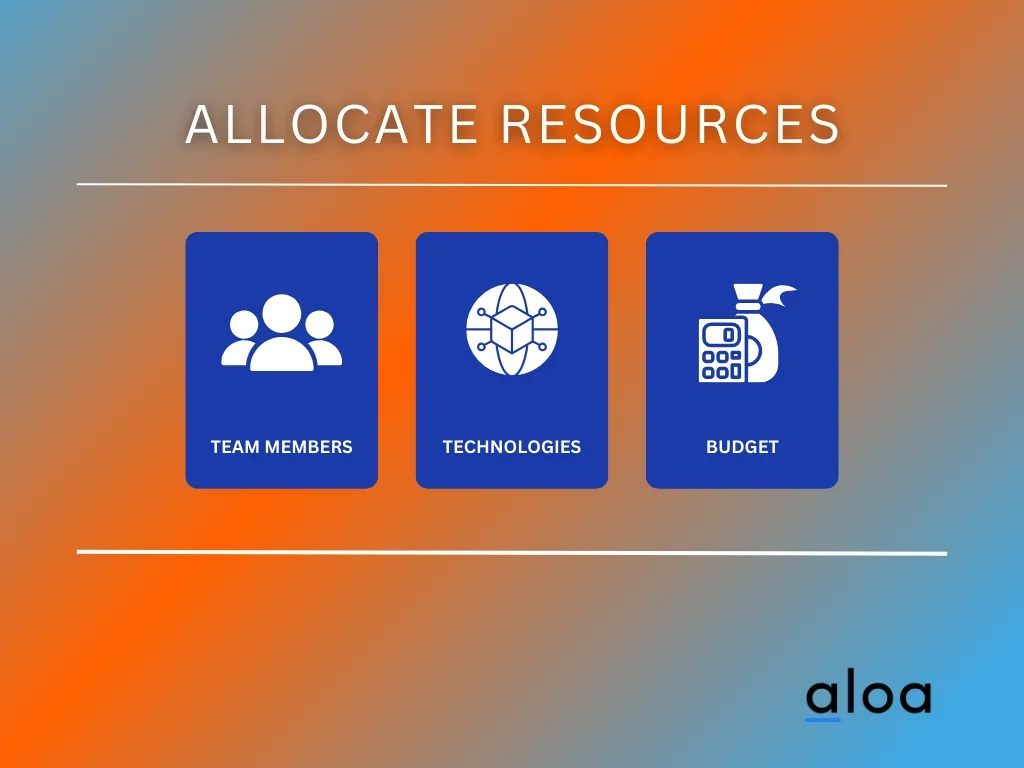
- Team Members: Thoroughly assess the project's scope and skill requirements, handpicking team members with the expertise to meet specific challenges. Emphasize collaboration among project stakeholders and team members to foster a dynamic working environment.
- Technologies: Stay at the forefront of technological advancements by selecting tools and technologies that align with the project's objectives. Ensure seamless integration and compatibility to enhance efficiency throughout the development process.
- Budget: Allocate financial resources judiciously, considering short-term needs and long-term sustainability. Regularly reassess and reallocate budgetary provisions as the project progresses, adapting to unforeseen challenges and opportunities.
Meticulous resource allocation is the bedrock of successful software development. Prioritizing the assembly of a skilled team can adopt cutting-edge technologies, and managing the budget judiciously, projects are poised for efficient execution and optimal outcomes.
Step 6: Identify Stakeholders and Define Roles
Identifying stakeholders and defining their roles involves active engagement with the project's ecosystem. Once identified, each stakeholder's role is meticulously defined, ensuring a streamlined and efficient workflow throughout the project lifecycle. Here are some things to consider when identifying stakeholders and defining roles:
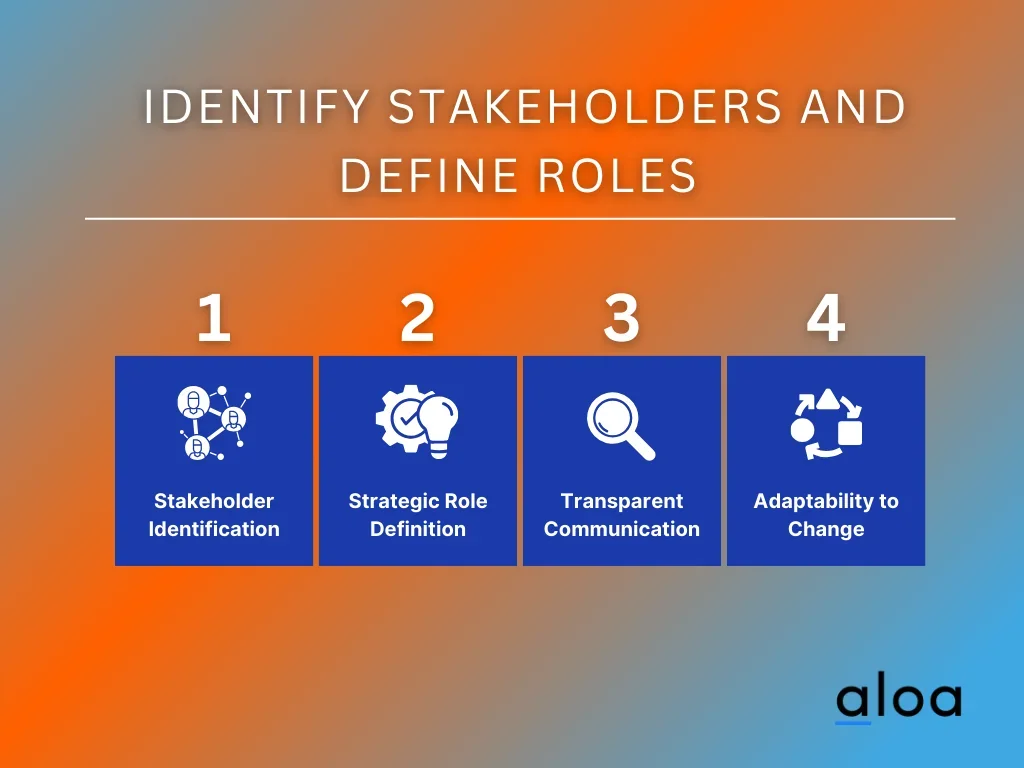
- Holistic Stakeholder Identification: Create a comprehensive list of all individuals or entities invested in the project's success.
- Strategic Role Definition: Define the roles and responsibilities of each stakeholder with strategic precision, ensuring a clear understanding of their contributions.
- Transparent Communication Channels: Establish transparent communication channels, fostering an environment where stakeholders can seamlessly interact and collaborate.
- Adaptability to Change: Recognize that roles may evolve throughout the project; cultivate an adaptive mindset to accommodate changes in responsibilities as needed.
Identifying stakeholders and defining roles ensures that all contributors are aligned with the project's vision, fostering a harmonious and productive environment for project development.
Step 7: Establish Project Constraints and Risks
Creating a comprehensive project plan requires thoroughly examining potential roadblocks and uncertainties. Project constraints, ranging from budget limitations to resource constraints, can impede progress. Simultaneously, risks, such as unforeseen technical challenges or external market shifts, can jeopardize the project's success.
Thus, identifying these elements at the outset empowers project teams to navigate challenges and proactively steer the project toward success.
In addressing project constraints and risks, teams set the stage for a resilient and adaptive execution. This strategic approach ensures that the project sails smoothly through effective mitigation strategies. As teams establish a robust foundation through constraint and risk assessment, they can pave the way for a successful and well-executed project.
Template of a Scope Document
In crafting a comprehensive scope document for software development, several key elements must be considered to ensure clarity and efficiency throughout the project lifecycle. Here's a comprehensive template outlining key elements crucial for a project's success.
Project
The project section succinctly encapsulates the overarching initiative. It identifies the software development endeavor, clearly understanding its essence. It even acts as the narrative foundation upon which the subsequent sections build.
Objective
This encapsulates clearly stated objectives from the lighthouse guiding the project team. These objectives embody the intended outcomes, elucidating what the software aims to achieve. They serve as the rallying point, ensuring everyone is aligned on the overarching goals.
Scope
The scope section delineates the boundaries of the project. It distinctly outlines what's included and, equally crucial, what lies beyond the project's purview. Clarity mitigates the scope creep risk, fostering a focused development trajectory.
Timeline
A well-crafted timeline is the temporal backbone of the project. It meticulously details the start and end dates, milestones, and crucial phases. A precise timeline is instrumental in managing resources efficiently and ensuring timely project delivery.
Deliverables
This section itemizes the tangible outputs expected from the development process. From software modules to documentation, each deliverable is defined with specificity. This clarity prevents ambiguity and sets the standard for quality expectations.
Dependencies
No project exists in isolation. Dependencies pinpoint external factors and interdependencies within the project. Recognizing and acknowledging these dependencies enables the project team to navigate potential bottlenecks and hurdles more effectively.
Examples of a Scope Document for Software Development
Crafting a scope document for software development projects requires attention to detail and clarity to ensure the project's success. Let's delve into some examples that illustrate the key components of a well-structured scope document.
Software Development Team Scope of Work
Project: Implementation of a CRM System Upgrade
- Objective: Enhance customer relationship management by upgrading the existing CRM system with advanced features.
- Scope: Includes requirement analysis, software customization, integration with existing systems, user training, and post-implementation support.
- Timeline: Eight months, with phased implementation to minimize disruption.
- Deliverables: Upgraded CRM system, user manuals, training sessions, and technical support documentation.
- Dependencies: Collaboration with the IT department for infrastructure readiness, user feedback for customization, and availability of vendor support for integration.
Research and Development Team Scope of Work
Project: Design of Next-Generation Renewable Energy Technology
- Objective: Develop an innovative renewable energy technology to address environmental concerns and meet growing energy demands.
- Scope: Conceptualization, prototyping, performance testing, scalability assessment, and pilot deployment.
- Timeline: Eighteen months, with iterative design improvements and feasibility studies.
- Deliverables: Functional prototype, technical specifications, performance data, and feasibility analysis report.
- Dependencies: Collaboration with engineering firms for prototype fabrication, regulatory compliance assessment, and funding agency requirements.
Marketing Team Scope of Work
Project: Rebranding and Product Relaunch
- Objective: Revitalize brand image and reintroduce product line to capture new market segments.
- Scope: Conduct market research, develop brand identity, redesign packaging, create promotional materials, and execute launch events.
- Timeline: Six months, with phased rollout across different markets.
- Deliverables: Brand style guide, packaging redesign, marketing collateral, event planning, and post-launch evaluation.
- Dependencies: Collaboration with design agencies for brand assets, coordination with the sales team for distribution, and customer feedback integration for product improvements.
Benefits of Having a Scope Document for a Software Development Project
A scope document is the cornerstone of any successful software development endeavor, outlining the project's boundaries, objectives, and deliverables. Here are five compelling reasons why having a comprehensive scope document is imperative for software development projects:
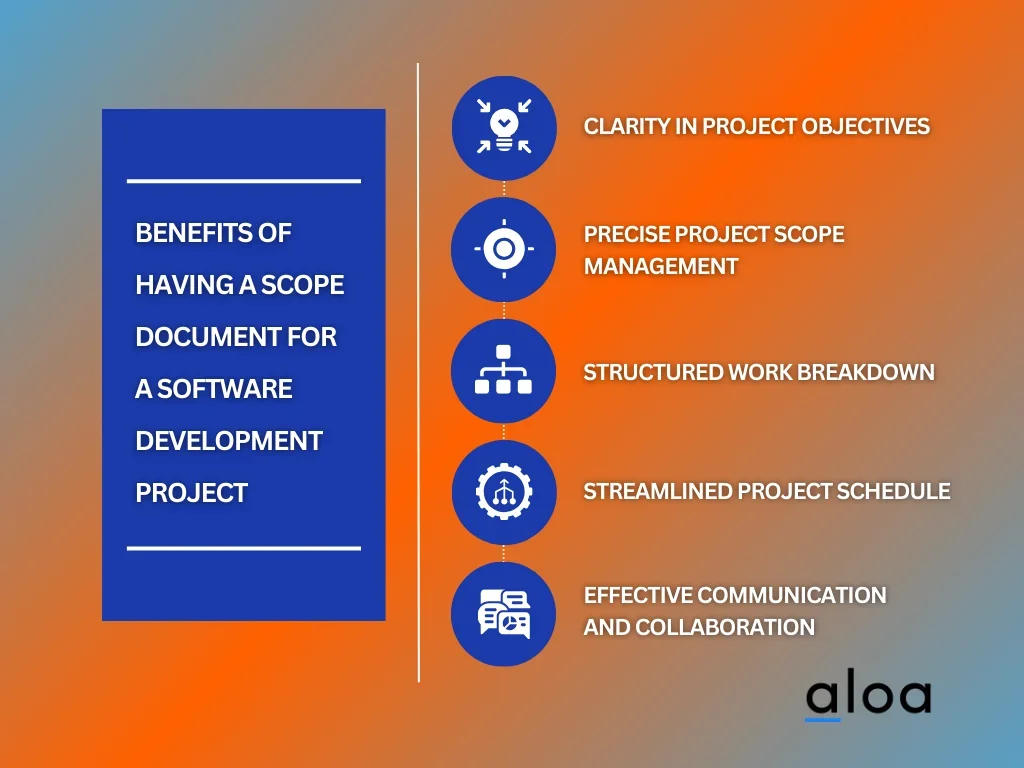
Clarity in Project Objectives
A scope document is instrumental in creating a clear and concise outline of the project's objectives. It acts as a guiding beacon, ensuring all team members are on the same page regarding the project's goals and deliverables. This clarity minimizes the chances of misunderstandings or misinterpretations, fostering a more efficient project management process.
Precise Project Scope Management
A well-drafted scope document includes a detailed scope statement delineating the project's boundaries. This, in turn, facilitates effective scope management by providing a clear understanding of what is and isn't part of the project. Team members can refer to the document to ensure they stay within the defined scope, minimizing scope creep and enhancing project control.
Structured Work Breakdown
The scope document serves as the startup's project template, aiding in creating a work breakdown structure. This breakdown delineates specific tasks, creating a roadmap for the project team. Once drafted, it enhances efficiency by breaking the project into manageable components, making it easier to assign responsibilities and track progress.
Streamlined Project Schedule
The project timeline in the scope document is pivotal in ensuring the project stays on track. It outlines key delivery dates and milestones, providing a clear roadmap for the entire team. This element is crucial in project management, allowing for effective planning and resource allocation.
Effective Communication and Collaboration
The scope document acts as a bridge between project stakeholders, providing a perfect place for communication and collaboration. Team members can refer to the document for details, ensuring everyone is aligned with the project's scope and objectives. This cohesive understanding fosters a collaborative environment where everyone works towards a shared vision.
Key Takeaway
The scope document plays a pivotal role in the success of software development projects. With a well-crafted project scope plan, stakeholders gain clarity on project boundaries and deliverables, reducing the likelihood of scope creep and misaligned expectations. This document is a product roadmap, guiding the project from initiation to completion with defined milestones and deadlines.
Recognizing the importance of a scope document in ensuring project success underscores the need for meticulous planning and communication. Aloa's experience and expertise in crafting comprehensive project scope plans support startups, project managers, and software developers. They adhere to the best practices in scope documentation creation, helping you to mitigate risks, manage resources efficiently, and deliver successful software solutions.
With Aloa's guidance, you can enhance your project management skills, ensuring the success of your software development projects. Our expertise in developing comprehensive scope documents is at your disposal, offering you the tools and knowledge needed to navigate the complexities of software project management.
For further guidance and assistance in creating an impactful project scope plan, sign up for Aloa's email list and start your journey toward success!

